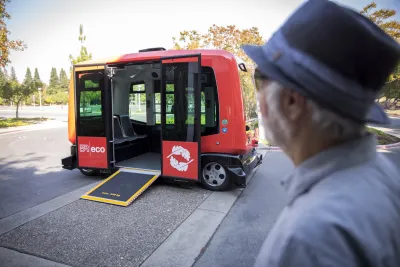Using alternate transportation and driving less can help older drivers keep themselves and others safe. But with many living on fixed incomes in car-dependent communities, how realistic is the NHTSA’s recommendation for a "transportation plan"?

As part of its Older Driver Safety Awareness Week, the National Highway Traffic Safety Administration (NHTSA) recommends that older drivers prepare a "transportation plan" to reduce their driving and decrease their risk of traffic accidents. But for many Americans living in car-dependent areas, this is more easily said than done.
While the NHTSA offers suggestions such as adaptive equipment, the agency fails to address the gaps in public transit infrastructure that keep many seniors dependent on their car for basic needs. "That’s a serious problem for a population group that has the single highest rate of fatal car crashes per mile, and who are more likely to be involved in multi-car crashes rather than single-vehicle impacts that harm only themselves," writes Kea Wilson of Streetsblog USA. In 2018, 19% of traffic fatalities were people over 65.
Although a third of Americans over 60 say that they have a disability that makes driving difficult, an overwhelming majority of them still drive their vehicles. With fatalities involving elderly drivers and pedestrian deaths soaring, increasing the availability and convenience of public transportation for car-dependent seniors is an important part of improving traffic safety for all age groups.
FULL STORY: Memo to Feds: To Keep Seniors Safe on Our Roads, End Car Dependence
National Parks Layoffs Will Cause Communities to Lose Billions
Thousands of essential park workers were laid off this week, just before the busy spring break season.

Retro-silient?: America’s First “Eco-burb,” The Woodlands Turns 50
A master-planned community north of Houston offers lessons on green infrastructure and resilient design, but falls short of its founder’s lofty affordability and walkability goals.

Delivering for America Plan Will Downgrade Mail Service in at Least 49.5 Percent of Zip Codes
Republican and Democrat lawmakers criticize the plan for its disproportionate negative impact on rural communities.

Test News Post 1
This is a summary

Test News Headline 46
Test for the image on the front page.

Balancing Bombs and Butterflies: How the National Guard Protects a Rare Species
The National Guard at Fort Indiantown Gap uses GIS technology and land management strategies to balance military training with conservation efforts, ensuring the survival of the rare eastern regal fritillary butterfly.
Urban Design for Planners 1: Software Tools
This six-course series explores essential urban design concepts using open source software and equips planners with the tools they need to participate fully in the urban design process.
Planning for Universal Design
Learn the tools for implementing Universal Design in planning regulations.
EMC Planning Group, Inc.
Planetizen
Planetizen
Mpact (formerly Rail~Volution)
Great Falls Development Authority, Inc.
HUDs Office of Policy Development and Research
NYU Wagner Graduate School of Public Service




























